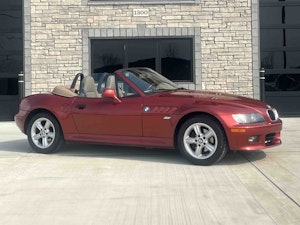Media | Articles
Vanishing Point: Death, destiny, a missing scene, and a mysterious black car
There was always something disconcerting to me about the movie Vanishing Point. Sure, like everyone else, I was shocked by the ending—but I always felt the film never made an effort to explain Kowalski’s decisions, particularly with regards to the last one he makes. At best it’s obscure; at worst, it’s confusing.
Well, consider me confused no more. I saw a copy of the European release, with extra footage that had been edited out of the U.S. version, and it makes much more sense now! In fact, it’s hard not to think of Vanishing Point as essentially incomplete with those scenes. The lack of them effectively hamstrings the entire film. Which is saying a lot, as it’s already considered a cult classic in its compromised state.
On a practical note, the missing footage includes several shots of the sensor wires the police had setup on the roads to track the Challenger. (I always wondered how they were updating that big police map.) More importantly, there is a crucial scene involving an ominous hitchhiker, who acts as a conduit to Mr. Black himself: Death. Thanatos’ cameo is by none other than Charlotte Rampling. With her mysterious eyes & demeanor, clad in a dark robe with elegant trim, she gives an eerie edge to the encounter.
It’s not obvious if this scene happens in “real life” or merely in Kowalski’s speed-pill-ravaged mind. It was shot at night, in a thick fog, and we don’t see much of the terrain other than a spooky tree Charlotte is standing under. Kowalski comes to a halt and tells her he’s going to San Francisco; she regards Kowalski wordlessly for a moment, then gathers her things. She gets in and the Challenger pulls away, red taillights vanishing into the darkness.
Marketplace
Buy and sell classics with confidence
Kowalski’s first line is “Have you been waiting a long time?”
An awkward conversation follows before Charlotte lights up a joint. Kowalski brings the Challenger to a halt. Things ease up a bit, and she asks Kowalski, “What are you?” before asserting, “You’re a Scorpio. What’s your name?”
“Kowalski,” she smiles as she repeats his name twice.
He asks Charlotte what her name is. She turns cold, stares away, and says, “I’ll tell you later.”
“Why are you going to San Francisco?” she asks.
“It’s home.”
“Home. You make it sound like a good place.” Again she regards him silently. Then we have the crucial dialogue that shakes Kowalski to his core, as she finally answers his initial question.
“I like you, Kowalski. I like you. I’ve been waiting for you for a long time. Oh, how I’ve waited for you.”
“Yeah? Since when? Where?”
“Oh, everywhere. Everywhere and since forever. Patiently. Patiently, that’s the only way to wait for somebody.”
They lock eyes for a while, as Kowalski processes this. All the crashes and near misses of his past, all the times he has cheated death, must flash through his mind.
Eventually Charlotte smiles & turns away, at which point a stunned Kowalski reaches out and willfully embraces Death for the first time.
Is she Death itself, or is she only channeling Death, after she tokes up? In various cultures, people often took drugs or fasted to reach an enlightened state, so they could commune with their gods or spirits. So it could be either. Kowalski and Rampling are both high, and in their own cozy little world, communing inside the parked Dodge R/T. “Mmm, feels nice in here,” she says, just before their soul to soul chat.
Now, throughout the whole movie, Kowalski is cast as a cool, nerves-of-steel kind of guy, who resists all sorts of temptations: free pot, and free sex from an utterly gorgeous and utterly naked Gilda Texter, whom we see riding a motorcycle around in the sand outside a hippy shack. Who can forget that memorable scene? Probably burned into every young man’s mind the first time they saw this movie. I know it’s still burned in mine. And Kowalski’s savior in that part of the film is a biker named “Angel.” Surely no coincidence?
So now we see Kowalski, stunned. Why? It’s obviously an important moment in the film.
Cut to the morning, and Kowalski wakes up alone in the car. Did this whole episode only occur in his imagination?
Let’s diverge for a moment, and consider something else: a mysterious black car, as I believe it ties into Charlotte Rampling’s visitation.
In film, rarely is anything done by accident. Props are set, everything is scripted, and if we see anything on screen, it is most definitely intended to be there, by the director. So why, at the beginning of the film, do we see a full-screen freeze frame with a mysterious black car in clear focus, the white Challenger R/T merely a blur in the background, as they pass each other? And then the camera pans to follow the black car away, not the Challenger, once film rolls again. The Challenger is one of the main characters in the whole movie: why would the director ignore it and pan along with a minor background vehicle? The answer is: it’s not a minor background vehicle.

So what is the director trying to tell us here?
Well, without the extra footage of Kowalski’s encounter with Rampling/Death, it doesn’t make much sense at all. But after viewing the cut scene, it takes on supernatural overtones.
“I’ll tell you later.” Is Death now driving the black car, whisking away Kowalski’s spirit?
At the beginning of the film, but later in the story, Kowalski veers off the road to avoid police ( After a dramatic skid & turnaround at the bulldozers ) and stops at a pile of wrecked cars in the desert. The setting sun casts shadows of the remains across his body; he pauses, puts his hand on the roof of a derelict, and stares down at the pile of rusted metal.
Then he smiles, as some thought enters his mind. he appears to make a decision, then gets back into the Challenger and drives away. We find out what happens next at the end of the film.
What’s going on in this key scene? It’s so early in the film that we have no context for it yet. Only upon subsequent viewing can we guess at what is being portrayed.
Consider Kowalski’s various flashbacks during the movie: Everything in his life is a wreck. His career, his relationships, his racing history. So when he pauses with his hand on that derelict at the beginning of the film, looking down at the wreckage, he realizes it, smiles, and decides to embrace the ultimate wreck. His destiny. His death. And indeed, Charlotte Rampling. (Who was brilliantly cast as the Reverend Mother in the latest Dune movie, by the way.)
When Vanishing Point was made, Rampling was an icon of the swinging Sixties, renowned for her cool demeanor, sultry looks, and mysterious gaze. She went on to do many art films, and eventually married Jean-Michel Jarre. I’m not surprised they were drawn to each other; his music matches her muse perfectly. She was gorgeous, yet had a deeper, darker aura, well suited for playing a foreboding role like Death incarnate.
Hell, I’d crash a car into a bulldozer for Charlotte Rampling circa 1971, but let’s get back to our story. At the very end, as the Challenger speeds towards the road block a second time, we see the glow on Kowalski’s face, cast by the setting sun blazing through the bulldozer blades. He has seen the light: his relief, joy, and serenity (surely enhanced by his non-stop amphetamine intake?) is visible, and he lays down the rubber road to freedom. Freedom from the wreckage of his life.
“Home. You make it sound like a good place.”
Does he actually think he can make it through the bulldozers? Is he so high he believes the sun is a reachable goal? Is he the manic laughter in Pink Floyd’s “On the Run”, joyfully speeding towards oblivion and destruction? Is his spirit already gone, taken by Death passing in the mysterious black car? Can he finally find peace, by accepting his destiny? Is he overjoyed he gets to spend eternity with Charlotte Rampling?
Many questions and ways to interpret the story. Which is true of any good art.
And as Neil Young sings, “Every junkie’s like a setting sun.”
So the black car was intentionally given a prominent role. Is it the very same car we see him drive into the garage, before he picks up the Challenger? Difficult to determine 100 percent, but the front end looks the same to me. And the license plate seems rather unique: I can’t make out those characters at all. Is it some more mystical symbolism?

If it is the same car, it’s an interesting loop the director put into the storyline.
In any event, no Vanishing Point (or Challenger) fan should miss a chance to see the Euro director’s cut of the film. Like most good filmmaking, it explains a few things while raising more questions. And isn’t that ambiguity part of why this old B-movie continues to captivate viewers 50 years later?










a far under rated movie because people do not look in depth of life and just go through the motions without paying attention.
Part of Vanashing Point was edited out just after the 11 minute mark. When Kowalski was in that Denver garage and asked which car he was going to transport. He starts walking through the garage and sees a Chevy then says “I don’t want any dog pile Chevy”. That sentence must have deeply offended the Chevy lovers so they had it removed.
i saw this movie 3 times with my brother(now deceased) when it first came out i had just bought a 1970 ‘cuda challengers cousin. I loved the movie then even more now that i’ve seen scenes i didnt see then. I recently saw it again since i have the bluray.His life reminds me alot of my own. Also the Honda the girl was riding was the same one i had except in blue. Im ready now for my ending to show up very soon. take care.
The sun was rising on the final scene, he had been with the strange woman all night, that was the following morning, also not realized with the scene cut. More to emphasize going to a new day instead of the dusk of his life.
Funny that this is such a recent discussion about an older movie that I’ve seen many times. Both with and without the extra scenes. I always thought the black car scene yes was Kowalski as the movie transitioned from present day to past. But what is unclear is at the beginning the Challenger stops at the bulldozers, turns, then meets with himself going the other way. Almost as if to fool the audience into thinking at the end when he approaches, that’s what he’s going to do. But then not. In essence starting off as ‘hope’ and then ‘submission’. Or here is an alternate ending first. And then the real ending.
This is a pretty interesting Roger Ebert interpretation:
https://watchingthe1970s.wordpress.com/2018/05/02/vanishing-point-1971-kowalski-and-the-happy-ending/